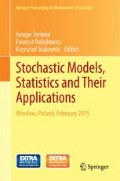Abstract
We apply the stationarity and cointegration monitoring procedure of Wagner and Wied in (Monitoring stationarity and cointegration. SFB823 Discussion Paper 23/14. http://hdl.handle.net/2003/33430, 2014) to monthly real exchange rate indices, vis-\(\grave{a}\)-vis Germany, of the first round Euro area member states. For all countries except Portugal structural breaks are detected prior to the onset of the Euro area crisis triggered in turn by the global financial crisis. The results indicate that a more detailed investigation of RER behavior in the Euro area may be useful for understanding the unfolding of the deep crisis currently plaguing many countries in the Euro area.
Access this chapter
Tax calculation will be finalised at checkout
Purchases are for personal use only
Notes
- 1.
Strong PPP is typically defined as a RER equal to one and thus its logarithm equal to zero. Typically, however, due to the lack of actual price data empirical analysis is confined to work with RER indices where the “level information” is lost.
- 2.
It is natural to normalize the potential cointegrating relationship on the price index p t – or \(p_{t}^{*}\) – rather than on the nominal exchange rate, which may have been fixed or almost fixed even before monetary unification (e.g., the exchange rate between the Austrian Schilling and the DM) and which is in that case almost by construction not an integrated process.
- 3.
These are Austria, Belgium, Finland, France, Germany, Greece, Ireland, Italy, Luxembourg, Netherlands, Portugal and Spain. Here it has to be noted that Luxembourg used the Belgian Franc prior to using the Euro and Greece was scheduled to join the Euro area in 2001 only. Thus, effectively we use the data for 11 countries as Luxembourg has to be excluded. As indicated in the main text we consider RERs with base country Germany. This is a natural choice given that Germany is the largest Euro area economy and the DM was the European anchor currency at the time. Alternatively, it is possible to calculate for each country its RER index with respect to the Euro area.
- 4.
The first quotation of the Euro was on January 4, 1999 and the physical introduction occurred at the beginning of 2002.
- 5.
- 6.
Only at the end of the period one observes RER depreciation relative to Germany in the peripheral crisis countries like Greece, Ireland, Portugal and Spain in line with the deep recession and structural transformation process ongoing in these countries.
References
Chu C-SJ, Stinchcombe M, White H (1996) Monitoring structural change. Econometrica 64:1045–1065
Eurostat: Exchange rates. http://epp.eurostat.ec.europa.eu/portal/page/portal/exchange_rates/data/database. Cited 10 Sep 2014
Kwiatkowski D, Phillips PCB, Schmidt P, Shin Y (1992) Testing the null hypothesis of stationarity against the alternative of a unit root. J Econ 54:159–178
OECD (10 Sep 2014) Main economic indicators. http://stats.oecd.org/Index.aspx?DataSetCode=MEI_PRICES. Cited 10 Sep 2014
Phillips PCB, Hansen BE (1990) Statistical inference in instrumental variables regression with I(1) processes. Rev Econ Stud 57:99–125
Saikkonen P (1991) Asymptotically efficient estimation of cointegrating regressions. Econom Theory 7:1–21
Vogelsang TJ, Wagner M (2014) Integrated modified OLS estimation and fixed-b inference for cointegrating regressions. J Econ 178:741–760
Wagner M (2005) The Balassa–Samuelson effect in “East & West”: differences and similarities. Rev Econ 56:230–248
Wagner M (2008) On PPP, unit roots and panels. Empir Econ 35:229–249
Wagner M, Wied D (2014) Monitoring stationarity and cointegration. SFB823 discussion paper 23/14. http://hdl.handle.net/2003/33430
Acknowledgements
Financial support from Deutsche Forschungsgemeinschaft via the Collaborative Research Center 823: Statistical Modelling of Nonlinear Dynamic Processes (Projects A1, A3 and A4) is gratefully acknowledged. The second author additionally acknowledges financial support from the Jubiläumfonds of the Oesterreichische Nationalbank (Grant No. 15334). The authors furthermore thank two anonymous referees for valuable suggestions.
Author information
Authors and Affiliations
Corresponding author
Editor information
Editors and Affiliations
Rights and permissions
Copyright information
© 2015 Springer International Publishing Switzerland
About this paper
Cite this paper
Aschersleben, P., Wagner, M., Wied, D. (2015). Monitoring Euro Area Real Exchange Rates. In: Steland, A., Rafajłowicz, E., Szajowski, K. (eds) Stochastic Models, Statistics and Their Applications. Springer Proceedings in Mathematics & Statistics, vol 122. Springer, Cham. https://doi.org/10.1007/978-3-319-13881-7_40
Download citation
DOI: https://doi.org/10.1007/978-3-319-13881-7_40
Published:
Publisher Name: Springer, Cham
Print ISBN: 978-3-319-13880-0
Online ISBN: 978-3-319-13881-7
eBook Packages: Mathematics and StatisticsMathematics and Statistics (R0)

